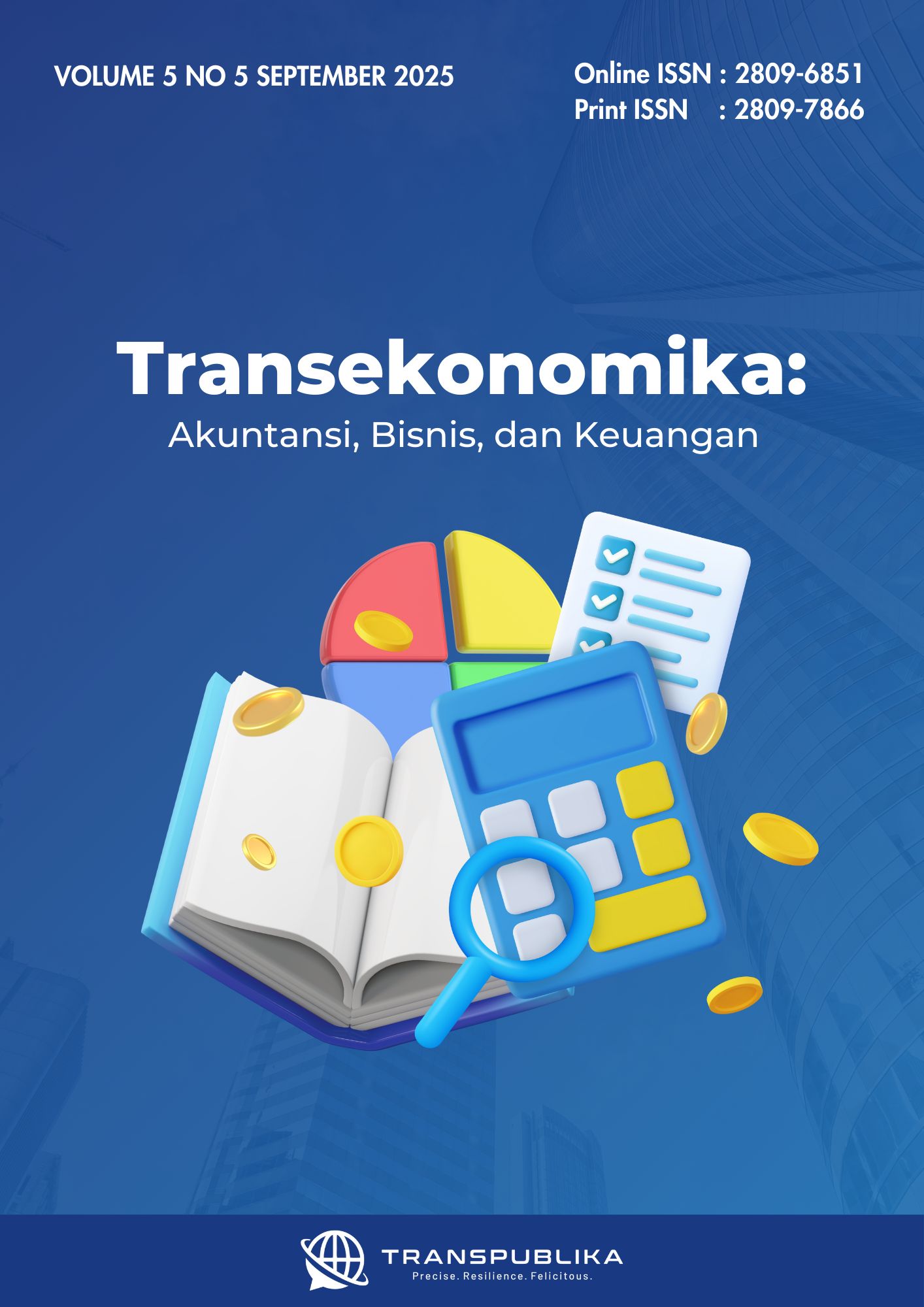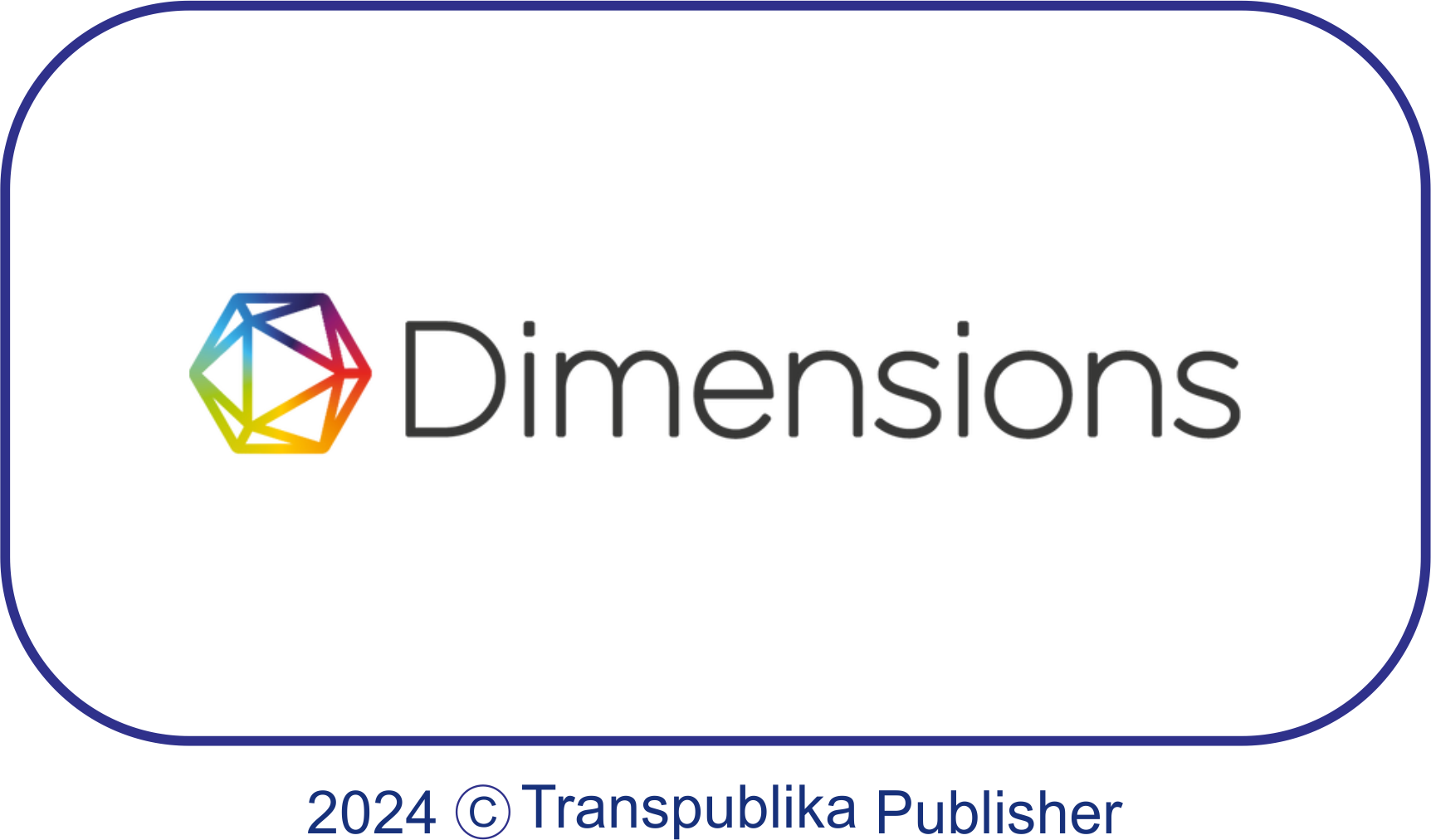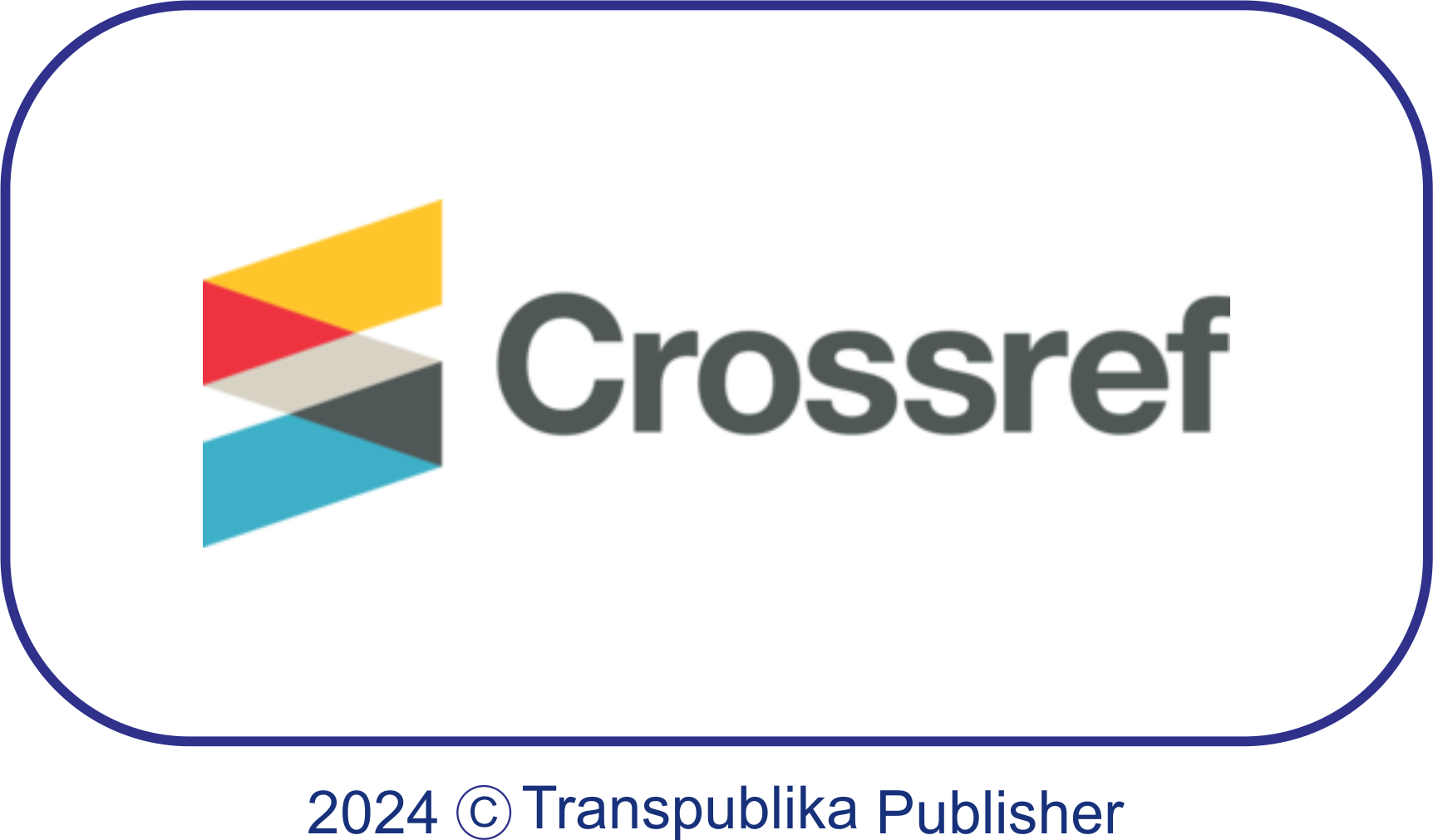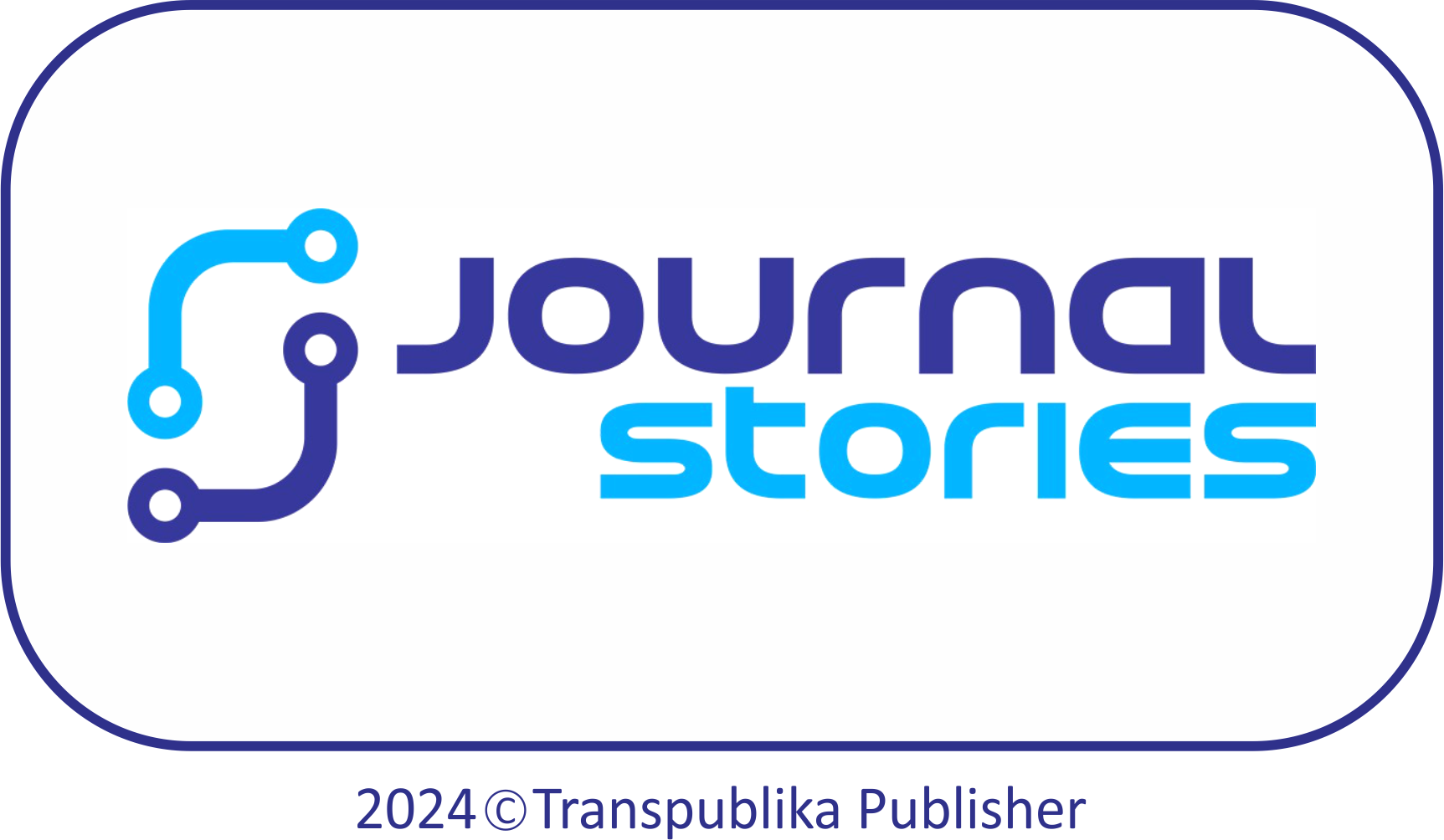Profitability Determinants in Rural Banks: The Moderating Role of Ownership
Abstract
The profitability of BPRs still faces serious challenges due to relatively low and fluctuating ROA performance compared to other banks. This raises the need to re-examine the financial factors and ownership structure that could potentially affect the performance of BPRs. This study investigates the factors affecting the profitability of rural banks (BPR) in Malang Raya and Pasuruan, Indonesia, with a focus on operational efficiency, credit risk, liquidity, bank size, and ownership structure. Using panel data from the Financial Services Authority (OJK), the study applies multiple linear regression to analyze 168 valid observations after data cleaning. The results reveal that operational efficiency (OER) and credit risk (NPL) negatively affect ROA, while larger bank size also reduces profitability. Liquidity, measured by Loan to Deposit Ratio (LDR) and Loan to Asset Ratio (LAR), does not significantly impact ROA. Furthermore, private ownership amplifies the negative effect of credit risk on profitability. These findings suggest that rural banks should focus on improving operational efficiency, managing credit risk more effectively, and addressing management inefficiencies, particularly in larger institutions. The study also highlights the importance of balancing profit maximization with robust risk management in privately owned banks. The implications of this research are valuable for policymakers and bank managers aiming to enhance financial performance and sustainability in the rural banking sector.
Downloads
References
Abdelaziz, H., Rim, B., & Helmi, H. (2020). The Interactional Relationships Between Credit Risk, Liquidity Risk and Bank Profitability in MENA Region. Global Business Review. https://doi.org/10.1177/0972150919879304
Allen, L., & Rai, A. (1996). Operational efficiency in banking: An international comparison. Journal of Banking and Finance, 20(4). https://doi.org/10.1016/0378-4266(95)00026-7
Anggraeni, A., Purnamasari, L., & Ardiyanto, H. (2023). Corporate Governance Dan Risiko Serta Ukuran Bank Terhadap Profitabilitas. SENTRI: Jurnal Riset Ilmiah, 2(8). https://doi.org/10.55681/sentri.v2i8.1409
Bahtiar, M. R., & Parasetya, M. T. (2022). Pengaruh Corporate Governance Terhadap Kinerja Keuangan Perusahaan Dengan Struktur Kepemilikan Sebagai Variabel Moderating (Studi Empiris Pada Perusahaan Perbankan yang Terdaftar Di Bursa Efek Indonesia Periode Tahun 2018–2020). Diponegoro Journal of Accounting, 11(4), 1–15. https://ejournal3.undip.ac.id/index.php/accounting/article/view/36352/27954
Bank Indonesia. (2011). Bank Indonesia Regulation No. 13/1/PBI/2011 concerning the Assessment of Commercial Bank Soundness.
Chaudhary, S. C. (2025). Credit Risk Management and profitability of Commercial Banks in Nepal. Medha: A Multidisciplinary Journal, 7(2). https://doi.org/10.3126/medha.v7i2.77194
Dalimunthe, N., & Lubis, N. K. (2023). Peran Lembaga Perbankan terhadap Pembangunan Ekonomi: Fungsi dan Tujuannya dalam Menyokong Ketenagakerjaan. Jurnal Masharif Al-Syariah: Jurnal Ekonomi Dan Perbankan Syariah, 8(4), 956–963. https://doi.org/10.30651/jms.v8i4.20997
Darto, D., Priharta, A., & Maryati, M. (2023). Capital Adequacy Ratio, Likuiditas, Efisiensi Operasional, Ukuran Perusahaan dan Profitabilitas: Bukti Empiris pada Bank Umum Syariah di Indonesia. BALANCE: Economic, Business, Management and Accounting Journal, 20(2), 132–138. https://doi.org/10.30651/blc.v20i2.18341
Farooque, O. Al. (2021). Agency-Linked Risk Management with Ownership and Board Sub-Committee Governance: Evidence from an OECD Economy. Journal of Risk and Financial Management, 14(10), 472. https://doi.org/10.3390/jrfm14100472
Fitri, M. A., Arsyadona, A., Febrianti, T., Zahwani, S. T., & Lubis, A. N. (2025). Peran Manajemen Risiko Dalam Meningkatkan Kinerja Bisnis. Jurnal Ilmiah Ekonomi Dan Manajemen, 3(2), 418–425. https://doi.org/10.61722/jiem.v3i2.3873
Gupta, D. O. P., & Dongre, N. (2024). Comparative Analysis of the Financial Performance of the Banks. International Journal of Research in Commerce and Management Studies, 6(02), 58–72. https://doi.org/10.38193/IJRCMS.2024.6206
Halim, H., Harefa, B., Bakhtiar, H., Wahyudi, S., & Halim, A. (2024). Application of Restorative Justice in Settlement of Child Crime According to the Law Enforcement Theory and Progressive Law. International Journal of Social Science and Human Research, 7(9), 7082–7102. https://doi.org/10.47191/ijsshr/v7-i09-42
Hendrastuti, R., & Harahap, R. F. (2023). Agency theory: Review of the theory and current research. Jurnal Akuntansi Aktual, 10(1), 85–100. https://doi.org/10.17977/um004v10i12023p085
Hu, Y., & Varas, F. (2025). Intermediary financing without commitment. Journal of Financial Economics, 167, 104025. https://doi.org/10.1016/j.jfineco.2025.104025
Junianti, P., Wibowo, N. M., & Hartati, C. S. (2023). Pengaruh Capital Adequacy Ratio Dan Non Performing Loan Terhadap Profitabilitas Melalui Loan To Deposit Ratio. Jurnal Ekonomi Bisnis Dan Manajemen, 1(2), 24–36. https://doi.org/10.59024/jise.v1i2.94
Kihuro, J. M. (2023). Effect of Bank Ownership on the Relationship between Credit Risk and Financial Performance of Commercial Banks in Kenya. Journal of Finance and Accounting, 7(1), 91–99. https://doi.org/10.53819/81018102t2121
Luana, M., Adam, M., Widiyanti, M., & Fuadah, L. (2024). The Influence of Ownership Structure, Non-Performing Loans, and Long-Term Debt on the Financial Performance of Banking Companies in ASEAN. Enrichment: Journal of Multidisciplinary Research and Development, 2(8), 1–7. https://doi.org/10.55324/enrichment.v2i8.220
Mandagie, Y. (2021). Analyzing the Impact of CAR, NIM, and NPL on ROA of Banking Companies (An Empirical Study on BEI Listed Companies). INQUISITIVE : International Journal of Economic, 1(2), 72–87. https://doi.org/10.35814/inquisitive.v1i2.2245
Mardiatmoko, G. (2024). The application of the classical assumption test in multiple linear regression analysis (a case study of the preparation of the Allometric Equations of Young Makila). JTAM (Jurnal Teori Dan Aplikasi Matematika), 8(3), 724–739. https://doi.org/10.31764/jtam.v8i3.22179
Martsila, I. S., & Meiranto, W. (2013). Pengaruh corporate governance terhadap kinerja keuangan perusahaan. Diponegoro Journal of Accounting, 2(4), 209–222. https://ejournal3.undip.ac.id/index.php/accounting/article/view/4470/4298
Moloi, T., & Marwala, T. (2020). The agency theory. In Artificial Intelligence in Economics and Finance Theories (pp. 95–102). Springer. https://doi.org/10.1007/978-3-030-42962-1
Muthia, F., Ghasarma, R., Andaiyani, S., & Setiawan, R. (2020). The Nexus Between Operational Risk and Profitability in Islamic Banking. Proceedings of the 5th Sriwijaya Economics, Accounting, and Business Conference (SEABC 2019). https://doi.org/10.2991/aebmr.k.200520.067
Nguyen, M. N., Tran, D. V., & Nguyen, V. (2024). Do banks with more able managers get better funding costs? Finance Research Letters, 61, 104982. https://doi.org/10.1016/j.frl.2024.104982
Nikolchuk, Y., Shvabii, K., & Kasyanov, V. (2023). Liquidity of a Commercial Bank: Theoretical Aspect. Herald of Khmelnytskyi National University. Economic Sciences, 320(4), 86–94. https://doi.org/10.31891/2307-5740-2023-320-4-12
OJK. (2014). Financial Services Authority Regulation Number 20/POJK.03/2014 concerning Rural Banks.
OJK. (2020). Financial Services Authority Circular Letter Number 9/SEOJK.03/2020 concerning Transparency and Publication of Conventional Commercial Bank Reports.
OJK. (2022). Circular Letter of the Financial Services Authority Number 11/SEOJK.03/2022 concerning the Assessment of the Soundness Level of Rural Banks and Sharia Rural Banks.
OJK. (2024). Sharia Banking Statistics.
Othman, J., & Gabbori, D. (2024). Navigating credit risk in Islamic banks: A multidimensional analysis of non-performing loans. International Journal of Islamic Finance and Sustainable Development, 16(4), 4–21. https://doi.org/10.55188/ijifsd.v16i4.928
Possler, D., Bowman, N. D., & Daneels, R. (2023). Explaining the formation of eudaimonic gaming experiences: a theoretical overview and systemization based on interactivity and game elements. Frontiers in Communication, 8, 1–14. https://doi.org/10.3389/fcomm.2023.1215960
Prabowo, F. P. S. R., Halim, Sarita, B., Syaifuddin, D. T., Sujono, Saleh, S., Hamid, W., & Budi, N. (2018). Effect of Equity To Assets Ratio (EAR), Size, And Loan to Assets Ratio (LAR) On Bank Performance. IOSR Journal of Economics and Finance (IOSR-JEF), 9(4), 01–06. https://www.academia.edu/download/64017433/IOSR Journal of Economics and Finance (IOSR-JEF) July-August 2018.pdf
Rakhmawati, S., Orbaningsih, D., & Lisa, O. (2021). Pengaruh Kecukupan Modal Dan Penyaluran Kredit Terhadap Profitabilitas Dengan Risiko Kredit Sebagai Variabel Pemoderasi Pada Perusahaan Bank Perkreditan Rakyat (Bpr) Di Malang Raya Periode 2017-2019. Prive: Jurnal Riset Akuntansi Dan Keuangan, 4(1), 1–16. http://www.ejournalbu.unigamalang.ac.id/index.php/RDOS/article/view/630/340
Ross, S. A., Westerfield, R. W., & Jordan, B. D. (2017). Essentials of corporate finance. McGraw-Hill.
Salsabila, A., Sujadi, E., & Sarmigi, E. (2024). The Effect of NPL, LDR, and CAR on ROA with NIM as a Mediation Variable in Conventional Bank Listed on The Indonesian Stock Exchange (BEI). Jurnal Ekonomi, 13(02), 1698–1710. https://ejournal.seaninstitute.or.id/index.php/Ekonomi/article/view/4339
Sukendri, N., Muktiyanto, A., Geraldina, I., & Safitri, J. (2024). Agency Theory in Banking: Balancing Incentives and Mitigating Moral Hazard in the Principal-Agent Dilemma. Pakistan Journal of Life & Social Sciences, 22(2), 22877–22887. https://doi.org/10.57239/PJLSS-2024-22.2.001627
Sunaryo, D. (2020). The Effect Of Capital Adequacy Ratio (CAR), Net Interest Margin (NIM), Non-Performing Loan (NPL), and Loan To Deposit Ratio (LDR) Against Return On Asset (ROA) In General Banks In Southeast Asia 2012-2018. Ilomata International Journal of Management, 1(4), 149–158. https://doi.org/10.52728/ijjm.v1i4.110
Suresh G, S. G., Angel, I. S., & Lavanya F, M. (2021). Impact of Ownership Structure on the Performance & Profitability of Banks. Journal of Contemporary Issues in Business and Government, 27(3), 185–192. https://cibgp.com/index.php/1323-6903/article/download/1584/1559/3070
Sutandijo, S., & Sugiyarti, L. (2022). Ukuran Bank, Manajemen Laba, dan Stabilitas Keuangan Bank. Scientific Journal Of Reflection : Economic, Accounting, Management and Business, 5(2), 310–320. https://doi.org/10.37481/sjr.v5i2.466
Sutanto, H., Meiryani, & Ariefianto, D. (2024). The dynamic relationships of credit risk, profitability, and capital: Evidence from Indonesia. Asian Economic and Financial Review, 14(3), 191–207. https://doi.org/10.55493/5002.v14i3.5014
Suwandi, S. H., & Nurdin, F. (2024). Profitabilitas BPR Malang: Pengaruh Perputaran Kas, Perputaran Piutang Dan Non Performing Loan. Jurnal Ilmiah Manajemen, Ekonomi, & Akuntansi (MEA), 8(3), 1595–1611. https://www.journal.stiemb.ac.id/index.php/mea/article/download/4613/2052
Syafitri, F., Ishak, G., & Samryn, L. M. (2023). The Effect of Current Ratio, Debt to Equity Ratio, BOPO, and GDP Growth on Return on Assets with Moderation of Firm Size in PT Pelabuhan Indonesia (Persero) Period 2018-2022. Journal of Social Research, 2(9), 2972–2982. https://doi.org/10.55324/josr.v2i9.1349
Wardana, M., & Setiadi, P. B. (2023). Pengaruh CAR, LDR, BOPO, dan NPL Terhadap Profitabilitas (ROA) Bank Perkreditan Rakyat Kota Malang (Tahun 2018-2021). Cakrawala Repositori IMWI, 6(2), 942–995. https://doi.org/10.52851/cakrawala.v6i2.290
Wardoyo, P., Purwantini, S., & Rusdianti, E. (2022). Determinasi Internal & Peran Ownership Concentratation Atas Profitabilitas Bank Perkreditan Rakyat (Di Kota Semarang). Owner, 7(1), 265–279. https://doi.org/10.33395/owner.v7i1.1230
Yulyanti, S., Lestari, R. A., Shaddiq, S., & Alhempi, R. R. (2022). The Effect of NPLS and LDR on the Profitability of Conventional Commercial Banks Listed on the IDX. International Journal of Latest Technology in Engineering, Management & Applied Science, 11(11), 90–93. https://doi.org/10.51583/ijltemas.2022.111104
Zhang, J., Chen, H., Zhang, P., & Jiang, M. (2022). Product market competition and the value of corporate cash: An agency theory explanation. International Review of Financial Analysis, 84, 102422. https://doi.org/10.1016/j.irfa.2022.102422
Copyright (c) 2025 Nyimas Nunin Anisah Baidury, Anggraeni Anggraeni

This work is licensed under a Creative Commons Attribution 4.0 International License.








.png)







.png)


.png)

.png)















